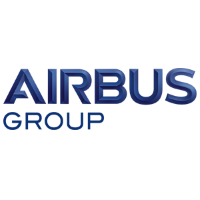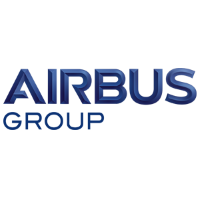
Airbus SE
PAR:AIR

Airbus SE





In the competitive skies of the global aerospace industry, Airbus SE stands as a formidable leader, weaving together innovation, efficiency, and strategic vision. Originating from a consortium of several European aerospace entities in 1970, it was created to challenge the dominance of American manufacturers in the commercial aircraft market. Airbus quickly became synonymous with technological advancement—it was the first company to introduce digital fly-by-wire control systems in commercial aircraft, a leap that has defined modern aviation. Over the years, the company’s portfolio has expanded significantly, ranging from commercial airliners like the A320 and A350 families to military aircraft and helicopters. The diverse offerings have cemented its position as a pivotal player in shaping aviation technology and expanding global connectivity.
The financial heartbeat of Airbus is driven by its Commercial Aircraft division, which constitutes the bulk of its revenue. With airlines and lessors around the globe vying for Airbus’s fuel-efficient aeroplanes, the company has successfully capitalized on the burgeoning demand for air travel. By maintaining a strong order book, Airbus ensures a steady revenue stream, manifesting from both aircraft sales and a suite of after-sales services, including maintenance and spare parts provision. Complementing this revenue channel is Airbus’s Defense and Space division, offering military aircraft, satellite systems, and related services. In addition, its Helicopters division caters to a wide array of civilian and military operations worldwide. Through a strategic blend of continuous innovation, timely delivery, and regulatory compliance, Airbus adeptly navigates the complex landscape of the aerospace market, generating sustained profitability and driving shareholder value.
Earnings Calls
This earnings call has not been analyzed yet.
If you’d like us to analyze this earnings call, click the "Request Earnings Call Analysis" button below.
Management

Dr. Thomas Toepfer is a notable executive with an extensive background in finance and leadership roles across various industries. He joined Airbus SE as the Chief Financial Officer (CFO) in 2023. Before his role at Airbus, Dr. Toepfer was the CFO and member of the Executive Board at Covestro, a leading polymer company, where he played a crucial role in the company’s financial strategies and performance. He holds a Ph.D. in Business Administration and Economics, demonstrating his strong academic background, and has accumulated significant experience in key leadership positions throughout his career. His expertise includes financial management, strategic planning, and organizational restructuring, which have been instrumental in driving growth and efficiency in multinational corporations. Dr. Toepfer’s career began in various finance-related roles, including positions at companies like Bayer and KION Group, where he honed his skills in financial oversight and strategic corporate development. At Airbus, he is responsible for overseeing the financial operations and ensuring the company's fiscal health, contributing to its global strategic objectives. His leadership is marked by a focus on innovation, sustainability, and digital transformation, aligning with Airbus's goals of advancing in these critical areas. His experience and strategic acumen continue to make a significant impact on Airbus's operational and financial outcomes.

Sabine Klauke is the Chief Technology Officer (CTO) at Airbus SE, a leading aerospace corporation. In her role as CTO, she is responsible for guiding the company's technology and innovation strategies, focusing on sustainable aerospace technologies. Klauke's expertise plays a critical part in advancing Airbus’s objectives in areas such as decarbonizing the industry and developing zero-emission aircraft. Before becoming CTO, Klauke held various significant positions within Airbus, showcasing her leadership and engineering prowess. She has a strong academic background, including a degree in Mechanical Engineering and a Ph.D. in Engineering, both of which have provided her with a solid foundation for her roles in the aerospace sector. Throughout her career at Airbus, Klauke has demonstrated a commitment to fostering technological advancements and has been involved in a variety of initiatives to promote innovation and environmental sustainability in aviation. Her leadership continues to be instrumental in driving Airbus's success and its contributions to the future of the aerospace industry.

Catherine Jestin is an executive at Airbus SE, serving as the Executive Vice President of Digital and Information Management. In this role, she is responsible for driving the digital transformation across the company to enhance Airbus’s industrial operations, products, and services. Jestin focuses on leveraging digital tools, data analytics, and information management to foster innovation and improve efficiency within Airbus. Before joining Airbus, Catherine Jestin held significant positions in various industries, specializing in digital strategies and information technology. Her leadership is characterized by a commitment to empowering teams and creating value through technology-driven solutions. Her experience in digital transformation and IT makes her a pivotal leader in steering Airbus through its technological evolution.

John Harrison served as the General Counsel of Airbus SE. In this role, he was responsible for overseeing the company's legal affairs and compliance programs. Harrison joined Airbus in June 2015, bringing with him extensive experience in managing legal and compliance matters on a global scale. Before his tenure at Airbus, he held key legal positions in multinational companies and was known for his strategic approach to navigating complex legal landscapes. His leadership contributed significantly to Airbus's efforts in maintaining robust legal frameworks and ensuring regulatory compliance.

Julie Kitcher is a prominent executive at Airbus SE, where she has held key leadership roles. As the Executive Vice President of Communications and Corporate Affairs, she has been a vital part of Airbus's management team. She is responsible for the company's global communication strategies, ensuring that Airbus maintains a strong and positive reputation worldwide. Julie joined Airbus in 2000 and has since built an extensive career within the company, gaining significant experience across various roles before stepping into her executive position. Her expertise encompasses investor relations, financial communication, and media relations, reflecting her comprehensive understanding of both the aerospace industry and corporate communication. In her current role, Julie is also responsible for corporate affairs, which includes overseeing public policy and company-wide initiatives related to sustainability and corporate social responsibility. Her leadership has been instrumental in advancing Airbus’s commitment to transparency and stakeholder engagement. Julie Kitcher is widely recognized for her strategic vision and her ability to effectively communicate complex business strategies to diverse audiences. Her contributions have significantly shaped Airbus’s public image and its approach to global communication challenges.

Thierry Baril is a prominent executive known for his role at Airbus SE, where he serves as the Chief Human Resources Officer (CHRO). He joined Airbus in 2007 and has played a crucial role in managing and developing the company's workforce across various global locations. Baril has a strong background in human resources and management, bringing significant experience to Airbus. Before joining Airbus, he held several key HR positions, including at Eurocopter, which is also part of the Airbus Group. His leadership in HR has been instrumental in fostering a culture of innovation and efficiency within the company. He holds a Master’s degree in Business Administration and has cultivated a reputation for his strategic approach to human resource management. His career is distinguished by a focus on talent development, organizational transformation, and enhancing employee engagement, all of which have been critical to supporting Airbus's growth and competitiveness in the aerospace industry. Baril’s work supports Airbus's goal of being a top employer in the aerospace sector, attracting and retaining top talent worldwide.

Didier Lux is a prominent figure in the aerospace industry, known for his significant contributions during his time with Airbus SE. He held various leadership positions, primarily focused on customer services, helping to forge vital relationships between Airbus and its clients. With a strong background in engineering and customer support, Lux was instrumental in enhancing Airbus's service capabilities and ensuring that the company met the evolving needs of its airline customers. His leadership style and strategic vision helped Airbus maintain a competitive edge in the global aerospace market, fostering innovation and improving customer satisfaction. His work ensured that Airbus's commitment to quality and reliability translated into strong, lasting partnerships across the aviation sector.
Geneviève Laurens-Chassagne is a notable executive known for her role within Airbus SE. She has held significant positions in the company, contributing to its financial and strategic direction. As the Head of Investor Relations at Airbus, Laurens-Chassagne played a crucial role in managing the company's relationships with investors and the financial community, ensuring clear communication about Airbus's financial health, strategic initiatives, and market outlook. Her expertise in finance and investor relations has been pivotal in fostering investor confidence and supporting Airbus's growth objectives. Laurens-Chassagne's career reflects her strong background in finance and corporate communications, making her a key figure in aligning investor interests with the company's goals.

Philippe Mhun is a senior executive at Airbus SE, the European multinational aerospace corporation. He serves as the Chief Programs & Services Officer, a position that plays a crucial role in overseeing the company’s commercial aircraft programs and services. Mhun is responsible for managing the lifecycle of Airbus's products, ensuring they meet customer expectations and maintaining efficient service operations. His career at Airbus has been marked by extensive experience in both engineering and customer service, which equips him with a deep understanding of the technical and commercial aspects of aerospace operations. Before his current role, Mhun held various significant positions within Airbus, contributing to the company's strategic focus on innovation and customer satisfaction. Philippe Mhun's expertise in engineering and program management has been instrumental in navigating the complexities of aircraft production and service delivery. He is known for his leadership skills and his ability to implement strategies that enhance operational efficiency and foster customer loyalty. His contributions are vital to Airbus's mission of maintaining its position as a leader in the aerospace industry.

Johan Pelissier is a notable executive at Airbus SE, particularly known for his role within Airbus Defence and Space. With a career spanning over two decades in the aerospace and defense industry, Pelissier has held various leadership positions that have significantly contributed to the company's operations and strategic direction. As an influential leader in Airbus's global team, he has been involved in the advancement of satellite communications, data services, and innovative aerospace solutions. His educational background in engineering and business management has supported his expertise in navigating complex projects and fostering partnerships across the aerospace sector. Pelissier is recognized for his leadership in promoting cutting-edge technology solutions and driving the development of sustainable and efficient aerospace systems. Throughout his career at Airbus, he has demonstrated an ability to adapt to industry changes and steer the company towards new growth opportunities in the competitive defense and space markets.


















































 You don't have any saved screeners yet
You don't have any saved screeners yet

Good day, and welcome to the Waste Connections Q1 2025 Earnings Call. [Operator Instructions] Please note this event is being recorded.
I would now like to turn the conference over to Ron Mittelstaedt, President and CEO. Please go ahead.
Okay. Thank you, operator, and good morning. I would like to welcome everyone to this conference call to discuss our First Quarter Results and to provide a detailed outlook for the Second Quarter. I'm joined this morning by Mary Anne Whitney, our CFO; and several other members of our senior management.
As noted in our earnings release, we're extremely pleased by the strong start to 2025 as price led organic solid waste growth and continued acquisition activity drove a top to bottom beat in the quarter, positioning us well for the full year. Exemplary operational execution supported core sale-based pricing of 6.9% and drove better-than-expected results as we overcome incremental volume weakness from protracted weather events across many markets to exceed our outlook and deliver adjusted EBITDA margin of 32%. Our industry-leading results are indicative of the durability of our unique approach to market selection, our decentralized operating model and the resulting projectability from our commitment to excellence.
To that end, we also saw continued improvement in employee retention for the tenth consecutive quarter, along with record safety performance during the period. Before we get into much more detail, let me turn the call over to Mary Anne for our forward-looking disclaimer and other housekeeping items.
Thank you, Ron, and good morning. The discussion during today's call includes forward-looking statements made pursuant to the safe harbor provisions of the U.S. Private Securities Litigation Reform Act of 1995, including forward-looking information within the meaning of applicable Canadian securities laws. Actual results could differ materially from those made in such forward-looking statements due to various risks and uncertainties. Factors that could cause actual results to differ are discussed both in the cautionary statement in our April 23 earnings release and in greater detail in Waste Connections filings with the U.S. Securities and Exchange Commission and the Securities Commission similar regulatory authorities in Canada.
You should not place undue reliance on forward-looking statements as there may be additional risks of which we are not presently aware or that we currently believe are immaterial, which could have an adverse impact on our business. We make no commitment to revise or update any forward-looking statements in order to reflect events or circumstances that may change after today's date.
On the call, we will discuss non-GAAP measures such as adjusted EBITDA, adjusted net income attributable to Waste Connections on both a dollar basis and per diluted share and adjusted free cash flow. Please refer to our earnings releases for a reconciliation of such non-GAAP measures to the most comparable GAAP measures. Management uses certain non-GAAP measures to evaluate and monitor the ongoing financial performance of our operations. Other companies may calculate these non-GAAP measures differently.
I will now turn the call back over to Ron.
Okay. Thank you, Mary Anne. We're off to a great start in 2025 in many respects, including pricing, employee retention and safety performance and acquisition integration, all driving better-than-expected revenue and adjusted EBITDA in the quarter. We delivered margins of 32% during the seasonally weakest quarter and what would arguably be characterized as an uncertain macro environment, further complicated by extreme weather in many markets and without any relief from commodities or FX.
Said another way, we're delivering on multiple fronts, starting with price-led organic solid waste growth. In the first quarter, core pricing was up sequentially to 6.9% and exceeded our outlook on the strength of pricing retention. Volume down 2.8% was in line with recent quarters in spite of incremental impacts from weather-related events that were most pronounced in February and followed by a pickup in March. To the inevitable question about how our business may have been affected by concerns about tariffs or other geopolitical elements impacting expectations or the economy more broadly. As is evidenced by our Q1 results, we didn't see any noteworthy impacts, including with respect to solid waste organic growth. In fact, we were impressed by favorable trends in volumes and pricing, both of which increased sequentially in the quarter, normalized for outside weather impacts.
To date, we have seen no incremental capital or expense increases associated with tariffs. Moreover, we were and continue to be impressed by the quality of execution from our local leaders and further advances in key operating trends. Notably, Q1 marked our tenth consecutive quarter of improvement in employee retention with voluntary turnover down another 60 basis points sequentially in Q1 to below 12% and down over 50% from our peak. At less than 12%, our voluntary turnover is within our targeted range with momentum for further improvement. Additionally, corresponding reductions in employee openings are allowing us to optimize staffing levels and focus on quality.
We would argue that voluntary turnover is the single most important metric to determine a company's overall health. As we have indicated would be the case, the benefits from improved employee engagement are spread throughout the P&L and position us for continued growth and margin expansion. We are seeing real-time benefits in reduced overtime less reliance on third-party services and lower vehicle wear and tear as well as improved employee morale and engagement that is translating to higher customer satisfaction levels as seen in sales, pricing retention and M&A integration, which, as noted earlier, are ahead of plan for 2025.
Most importantly, we see the value of employee engagement and safety, our #1 operating value and key performance indicator. Not only have we seen continuous improvement in company-wide incident rates over the past 2 years, but we have now achieved historic low levels. That is, we are experiencing safety incident rates that are lower than any other time in the company's history with dramatically more employees and vehicles. While acquiring and integrating in recent years, record levels of acquisitions, which typically come on at much higher incident rates, we have also driven down the number of safety-related incidents across our expanding footprint, reducing year-over-year incident counts by as much as 40% in recent months. This outsized improvement will unlock incremental cost savings in future periods from the lagging benefits of reduced severity and incidents, which continue to be headwinds being absorbed in the current period based on our prior year's performance.
Along with these achievements, our acquisition activity continues at outsized levels with annualized revenues closed to date already over $125 million, including a strategic state-of-the-art recycling facility in New Jersey to complement our growing New York City commercial collection franchise business discussed the past several quarters. Already approaching in 4 months what we used to consider an average year, we're on pace for another busy year with high levels of seller interest across our footprint. We should be well past an average M&A year by the midpoint of this year.
At debt-to-EBITDA leverage of 2.3x, we remain well positioned for continued acquisition outlays in 2025 and more importantly, their successful integration to drive value creation. The strength of our balance sheet and the consistency of our results provide tremendous optionality to execute on our growth strategy, along with increasing return of capital to shareholders. And we're extremely proud to report our recent receipt rating upgrade from Moody's ratings to A3, reflecting that track record and providing even greater support for our continued growth.
Now I'd like to pass the call to Mary Anne to review more in depth the financial highlights of the first quarter and provide a detailed outlook for Q2. I will then wrap up before heading into Q&A.
Thank you, Ron. In the first quarter, revenue of $2.228 billion was above the high end of our outlook and up $155 million or 7.5% year-over-year. Adjusting for foreign exchange impacts from the decline in the Canadian dollar, year-over-year revenue was up 8.4%. Contributions from acquisitions net of divestitures and operations closed since the year-ago period, totaled $112 million in the quarter.
As Ron noted, solid waste organic growth was led by 6.9% core price, which range from about 4.5% in our mostly exclusive market Western region to over 8.5% in our competitive markets. Total price of 6.7% reflected a reduction of about 20 basis points in fuel and material surcharges, primarily related to lower fuel rates. With over 75% of our price increases already in place or contractually provided for, we have high visibility for full year 2025 core pricing of at least 6%.
Looking next to solid waste volumes, which on a reported basis are normalized for the impact of 1 less day in the quarter and our closing of Chiquita Canyon landfill at year-end 2024. Q1 volume had negative 2.8% were in line with Q4, including 50 basis points attributable to outsized weather events, most notably in February, that contributed to reported volume losses to varying degrees across all of our regions, except our Western region. Volumes also reflect ongoing purposeful shedding and nonrenewal of poor quality contracts from acquisitions in recent years, similar to prior periods.
Looking at year-over-year results in the first quarter on a same-store day adjusted basis. Roll-off pulls were down 2% due primarily to February weather impacts, most notably to markets in the South and Southeastern U.S. In fact, excluding February, pulls were about flat year-over-year. Landfill tons were up 1%, higher MSW tons up 2% and increased special waste tons up 6% were partially offset by weaker C&D tons down 6%. Increases in special waste activity reflects some benefit from an easy comparison to last year and were broad-based across a number of smaller jobs in most of our regions, except our central region.
Looking at landfill tonnage by month, similar to roll-off activity, February was the only negative month. Otherwise, tons were up 4% to 5% year-over-year. Beyond solid waste, revenues played out largely as expected in Q1, with values for cardboard or OCC and mobile energy credits, or RINs, both down about 20% year-over-year and stable at those levels during the quarter, with offsets from increases in other commodities. In Q1, prices for OCC averaged about $105 per ton and RINs averaged about $2.45, with little movement in either thus far in Q2. And finally, E&P waste activity was about flat year-over-year, adjusted for acquisitions, with some declines associated with decreased rig counts in certain basins in the U.S. offset by drilling activity in other U.S. basins and production-oriented activity in Canada.
Adjusted EBITDA for Q1, as reconciled in our earnings release, was $712.2 million, up 9.5% year-over-year. At 32% of revenue, our adjusted EBITDA margin was above our outlet and up 60 basis points year-over-year. This increase was driven primarily by underlying solid waste margin expansion up 70 basis points, which along with 20 basis points net benefit from accretive acquisitions offset by closed operations, more than overcame a combined 30 basis point margin drag from lower commodity-driven revenues and FX. Net interest expense of $79.1 million with a weighted average cost of approximately 4% on quarter-end debt outstanding of about $8.4 billion, with a tenor of about 9 years and a mix of 80 to 20 fixed to floating rate debt.
Liquidity was approximately $570 million and our leverage ratio, as defined in our revolving credit agreement, and as noted by Ron, was about 2.73x debt-to-EBITDA. Our effective tax rate for the first quarter was 22.8%, about as expected. And finally, adjusted free cash flow of $332.1 million was in line with our expectations and our full year outlook of $1.3 billion to $1.35 billion as provided in February.
I will now review our outlook for the second quarter of 2025. Before I do, we'd like to remind everyone once again that actual results may vary significantly based on risks and uncertainties outlined in our safe harbor statement and filings we've made with the SEC and securities commissions or similar regulatory authorities in Canada. We encourage investors to review these factors carefully. Our outlook assumes no significant change in underlying economic trends. It also excludes any impact from additional acquisitions that may close during the remainder of the second quarter and expensing of traction-related items during the period.
Revenue in Q2 is estimated to be in the range of $2.375 billion to $2.4 billion. Adjusted EBITDA margin in Q2 is estimated at approximately 32.7%. Depreciation and amortization expense for the second quarter is estimated at approximately 13.1% of revenue, including amortization of intangibles of about $50 million or $0.14 per diluted share net of taxes. Interest expense net of interest income is estimated approximately $82 million. And finally, our effective tax rate in Q2 is estimated at about 24.5%, subject to some variability.
And now let me turn the call back over to Ron for some final remarks before Q&A.
Thank you, Mary Anne. Our strong start to the year validates the disciplined approach to growth and value creation that we have employed since our founding. With solid waste pricing largely in place and another busy start to acquisition activity, we are well positioned to build on that success in 2025, particularly given the benefits of employee engagement we're seeing today, which should continue to accrue to us in 2025 and beyond.
Looking at our outlook for the full year 2025 and acknowledging the broader macroeconomic uncertainty in the current environment as noted, we have thus far not seen significant changes to trends in activity or costs that would alter the outlook for 2025 that we provided in February. On that basis, we are reiterating our full year 2025 outlook for revenue, adjusted EBITDA and adjusted free cash flow, while acknowledging that uncertainty. Of course, we will continue to monitor trends as tariffs and other drivers may impact results, and we intend to review and provide any updates to our full year 2025 outlook in conjunction with our Q2 earnings release.
Regardless of the macro environment, we'll continue to focus on those aspects of the business that we can influence and position ourselves to address and mitigate the impacts outside of our control. To that end, we're most grateful for the commitment of our 24,000 employees who drive these outcomes, while putting safety first and making Waste Connections such a great place to work. We appreciate your time today.
I will now turn the call over to the operator to open up the lines for your questions. Operator?
[Operator Instructions] Our first question comes from Tyler Brown with Raymond James.
Ron, thank you for all the color on the tariffs. But in a similar vein, the financial markets are obviously up and down, interest rates are moving. And I think the HSR process got a little more difficult maybe in the past month or so. So number one, can you just talk about how those HSR changes do or don't affect you regarding M&A? And two, it doesn't sound like it, but is this uncertainty in the market having any material impact in getting deals and closing them?
Sure. Thanks, Tyler. So first off, I'm sure many on the call are aware that the HSR filing application process and timing changed effective February 8, 2025. The process, application became probably 3 to 4x more lengthy and the cost to prepare became probably 3 to 5x more expensive. The FCC and the DOJ are now saying that typical deals that might get reviewed in a 30- to 60-day process, people should now expect more like a 90 to 150-day process. So it is expected to lengthen out those deals that require HSR.
Now having said that, listeners should understand, 99% of our deals do not require an HSR filing because we are acquiring smaller private health companies almost exclusively under $125 million in purchase price. And so we have very, very few HSR filings. In fact, we currently have no deal slated for HSR filings and we have not had any year-to-date. So I am not looking for any delays in any of our M&A. But I can understand how if you're acquiring public companies or doing very large transactions there could be a slowing due to the change in the HSR process this past February.
Interesting. Okay. Yes. That's very, very helpful. Mary Anne, just so I have it. But the 2.8% volume decline, that excludes the Workday impact, right? Was that maybe something like 40 or 60 basis points, give or take?
That's right, Tyler. It's about 60 basis points would be that 1 day in the quarter.
Okay. But it does include the 50 basis points from weather. So if you kind of look at it somewhat clean, maybe the rate of volume declines actually improved a bit sequentially if you take out weather and Chiquita is obviously now in the Workday?
That's correct. And that's the point. I think Ron made that not only did we see sequential improvement in price, but we saw it in volume normalized for that. Net debt 2, 3 would be lower than most of the quarters last year, except one, where we had really lumpy outsized special waste contributions.
Okay. And then, Ron, just on landfill tons, I know those are probably kind of real-time indicator, if you will. Just I know you gave the monthly through March, but anything in April since all of this seemed to happen in April, just any date on the landfill tons?
Yes, I can provide that actually received it last night on our flash, Tyler. So the last 4-week average total tons are up 4.5%. And year-to-date, they were up exactly 3%.
Excellent. My last one here I just thought I was very interested in the comments about incidents. I think you said record lows. I'm curious what's driving -- yes, is that just cultural change or is technology helping? Just any color on what's driving that? And then maybe you can just help us understand how the insurance markets work. I know that not having an accident is good in real time, but it does take a while for it to show up in insurance premiums. Can you just maybe give us some color there?
Yes. Sure, Tyler. All right, multiple parts to that question. I'll try to answer. So first off, what is driving that is culture. Number one, more than technology. We have had a very robust technology for a very long period of time. We have used onboard cameras for over 20 years now. And of course, they have improved and the amount of views are improved. But our coaching effectiveness on risky drivers has improved company-wide to approaching 90% of all incidents that are detected on a daily basis via our technology. And that is a dramatic improvement for us. It's a huge cultural focus for us.
To give you a perspective, I mean, we would typically, 2 years ago in the month of March, we had about 400 and some incidents, which can be as little as tapping a mailbox. So let me clarify that. And in the month -- this year, in the month of March, we were in the 200s with dramatically more vehicles on the road and employees. So I would tell you that technology is part of it, but I would tell you it's 90% behavioral change through coaching and that's a cultural issue for us.
As far as the insurance market, you are right. Safety is a leading indicator or incidence is a leading indicator of performance but risk insurance is a lagging indicator. So we reset our premiums every August to September with third party for our umbrella coverages on our risk for both workers' comp and third-party liability. And your severity in the prior 2 years really determines what's happening in your forward period. So last August, we priced our insurance for the '25 calendar year, and that was based on the '23 and part of '24 performance. And that performance was not as good. We did have some serious losses in that period. And so that risk premium went up quite dramatically.
In fact, our 5-year CAGR on insurance premium is about a 17% to 18% increase per year. We are projecting with our current performance, if we hold that and continue this line, we'll begin dropping with the renewal this September. So we think we will start seeing some benefit in the P&L from our current performance throughout '26.
The only other thing that I would add to that is that one observation is around claims take multiple years to develop. And so as you describe it, the risk is actually a lagging indicator and that's what we tried to describe. The one observation would be is that lag is a little longer arguably coming out of the pandemic. When you had a couple of things happen, you had a whole slowdown in the processing of claims, therefore, the development. But then you also had outsized inflation. And so that has prolonged seeing the benefit in our P&L from our perspective. And as Ron said, we're looking forward to seeing that in the years ahead.
The next question comes from Konark Gupta with Scotiabank.
This is Ali filling in for Konark. Just one question. Are you seeing any meaningful changes in the RNG landscape, be it demand or pricing or competition due to a more pro carbon administration?
I would say that we really haven't, but if you think about where we are in the process of developing new facilities, bringing them online and existing facilities, we basically are -- this is a year of CapEx and the new facilities will be coming online in late '26. And so we might not be the best indicator of anything real time that might be developing there. What I can say is for existing facilities we have, as we noted in our remarks, that RINs are made very stable in that kind of 245 type of level. And we've seen them there really since the initial drop-off right after the election and the adjustment to the RVO last year, but they pretty much stabilized at current levels for most of Q1, and we haven't seen any change in Q2 to date.
The next question comes from Jerry Revich with Goldman Sachs.
This is Adam on for Jerry. Really strong core price of 6.9%, and it seems pretty robust in context of the guide initially put out of around 6%. Has your price plans changed at all since the start of the year? And it sounds like some of that has been driven by pricing retention. Are you seeing any change in pricing retention trends year-over-year or sequentially?
Yes. So number one, nothing has changed, Adam. I think we originally guided that our price guidance was 6% to 6.5% was the range that we thought we would target for the full year. Remember, Q1, because of a lower seasonal denominator weather-wise and seasonality is always the highest point of your price and then it will step down sequentially. It doesn't step down. It's just the denominator in the math changes. So it gives that appearance that the price is already input for the year. So no, there has been no change.
I would tell you that the retention of the price has been better so far year-to-date than at this point last year or in '23. So that, I think, is very favorable overall. I think we've been a little more surgical about it, we're certainly attempting to be, and I think that is helping somewhat too. I also believe our staffing levels and being fully staffed the way we are helps assisting both in our service quality as well as our customer service response. It all sort of feeds holistically to why we would hopefully retain more of that price. So that's really -- but there has been no change in our approach from the beginning of the year.
And then can you remind us how many different suppliers you use for your truck fleet? And it sounds like your visibility on capital is pretty locked in there for the year. But can you just update us on conversations you're having with suppliers in context of tariff-related inflation?
Yes. So first off, we use -- I mean, we predominantly use about 4 chassis manufacturers and 4 or so body manufacturers. Obviously, it depends on the type of the fleet, meaning front load, rear load, side load, et cetera. So 4 and 4. As of today, we only have 10 remaining chassis for '25 to be built. That could even potentially be subjective to tariffs, and we are being told that there is up to perhaps a $3,500 per chassis. So when we say there's virtually no exposure that's what we mean by that.
Body wise, we have not as of yet been told by a manufacturer, there will be any incremental tariffs or impacts to that. Now -- so we really have no concern about tariffs for our '25 CapEx to speak of. Now that could certainly change for '26 depending on what transpires with tariffs and what is included and excluded. But for this year, we do not have any impacts, and we are not hearing any. On the parts side, we are making a move in some of our locations where some of our parts were coming from various countries that would be subjected to tariffs we are moving some of that parts inventory to domestic American manufacturers to avoid any potential there.
And the next question comes from Trevor Romeo with William Blair.
First one I had was on the incremental M&A that you've kind of announced this quarter, I think you specifically called out the state-of-the-art recycling facility in New Jersey. Just wondering if you could talk about that asset a little bit more. Why was it up that look attractive to you from a strategic perspective? Just any more color on that would be great.
Sure. Happy to, Trevor. So the asset was a very large, as I said, state-of-the-art built within the last finish being built within the last 24 months, facility in the Hoboken, New Jersey area, just outside New York City. As you know, we have a very large presence in New York City and have been awarded 12 of the franchise areas in the city that will be rolled out over the course of the next 2 to 3 years and have just been started rolling out at the end of '24.
Along with that becomes a large amount of recycling that we're doing today and that we will need to be doing. This facility can process up to 20,000 tonnes per month, so 0.25 million tonnes a year. It is a highly, highly automated facility, as I said, state-of-the-art using AI technology from an optical sorting from an air classification, et cetera. The facility is processing about 13,000 to 14,000 tons a month right now as it speaks, and we have not begun to bring any of ours into it. So multi-generational company, very well-known company that had been in business in the New Jersey area for 70-plus years, had -- actually had a facility fire several years ago, about 3.5 years ago, and they ended up rebuilding this state-of-the-art facility.
So a company have been tracking for many years. And as we continue to grow there and knew we needed incremental processing after we acquired the Royal Waste transaction last year, we had been working on this. The Royal Waste transaction in New York City came along in Queens, with a fantastic recycling facility as well, but we are literally bursting at the scenes at that facility and needed incremental processing capacity to continue our expansion in New York City.
That's great color. And then maybe one for Mary Anne. I guess, on the Q2 guidance, I think the margins of 32.7%, if I heard you right, I think that's maybe a little less year-over-year expansion than what you've kind of seen lately. So are there any kind of headwinds to margin you call out in Q2? Or could you just kind of talk through some of the upside or downside to that Q2 margin?
Sure. Important to keep in mind really the drivers of last year's margins and the impact the commodities and acquisitions on reported margins. And so when I think about what changes year-over-year in Q2 versus Q1, there's about 40 basis points more drag in Q2, specifically from the fact that for commodities, Q2 was the highest level last year, and so the headwind is greater. And then you have less benefit from the rollover impact of acquisitions. Last year, of course, you had the benefit of secure and that dissipates over the course of this year, and that becomes a drag. So think of it as 40 basis points different, and that gets you very close to the year-over-year margin we just demonstrated in Q1.
And the next question comes from Toni Kaplan with Morgan Stanley.
This is Yehuda Silverman on for Toni Kaplan. Just a quick question on margins. What expectation embedded in the guide regarding inflation? Like how should we think about margins in 2025 if let's say inflation lingers rather than moderate?
Yes. So coming into the year, we certainly were mindful of the fact that CPI prints were lower, but we think in terms of our own cost inflation and not so much headline inflation as what's driving our -- the pricing and how we think about that. So as we've said, we're delivering 6% core price. And what we would say is that our cost inflation is running in the 4% to 4.5%. So that comfortably gives you the 150 basis point spread between cost and price that we typically look for more think in terms of and certainly feel very comfortable because what we've seen in terms of our major cost pressures led by labor specifically, is that those pressures have mitigated and so that spread is actually widening. So if in your example, if things were to pick up a little, we would absorb it with the pricing we've already done.
Great. And just one more question regarding volume. So especially given the slowdown years recently that have become more rampant, can you remind us which areas would get hit the most or impacted the both negatively and potentially positively during the slowdown?
Sure. So if you think about what is the most cyclically exposed piece of the solid waste business, that would be the roll-off side of collection, so construction levered and then, of course, construction and demolition debris at our landfills. To give you some context, in the aggregate, it's about 10% of our revenue, which is more cyclically exposed. And on the collection side, the way that you adjust to that dynamically adjust that is a point-to-point business. It's not route-based, so you have the opportunity, too. It's not only the lowest margin piece of the collection business, but you're able to dynamically adjust to activity levels. And so that's where you would expect to see it primarily in those areas.
The next question comes from James Schumm with TD Cowen.
Maybe, Mary Anne, just sort of following on to your point about price cost spread. You kind of -- you priced at 6.9% in the first quarter, your inflation is 4.5%. So the spread looks a lot wider here. Was there any thoughts to raising the 2025 guidance? Are you being a little conservative because we're so early in the year and the macro is uncertain or -- but it seems like that spread. You've got a lot of wiggle room there. Can you just talk to that a little bit?
Sure. Happy to address that. And important to clarify. So coming into any year, our reported price as Ron made reference to earlier, is it would typically be highest in Q1, and that's really just a function of the math of how you calculate the dollar contribution from price as the denominator gets bigger over the course of the year. So one shouldn't generalize from 6.9% in Q1. We said it's a little better than expected, and it gives us incremental conviction on 6% plus pricing the full year, but you should fully expect that number on a reported basis to step down over the course of the year. So that tells you that you'd step down from 6.9% to numbers that are lower than that, and optically, you'd go below 6% as you move through the year to average 6, right? So that's all in with our expectations, retention a little better in Q1. So that's the math on reported pricing.
The second point regarding adjusting our outlook after what we've described as a very strong Q1. The short answer is we typically don't review our outlook until the midpoint of the year when we have 2 quarters under our belt. If you think about it, we give quarterly guidance, so we give a lot of information each quarter. And even though Ron did take the opportunity to reiterate the full year that was really within the context of recognizing the macro uncertainty that was impacting other people's view of their numbers for the full year. So what people should expect is as is customary, we will make the adjustments reflecting any of the changes we've seen, whether they're acquisitions or commodity values or other things that impact the full year, we'll do that in July.
Got it. Great. Maybe I could squeeze 2 more quick ones in, if possible. What's the volume progression throughout the year? Can you give us a sense of how that trends and maybe what the exit rate is? And then lastly, SG&A was up 13% year over year in the first quarter. Just curious what's driving that? And what would -- what are your expectations for the rest of the year?
So starting with the SG&A. First, you need to normalize for the expensing of acquisition-related expenses that we adjust for. And so that comes out of SG&A. I think that was almost $13 million in the quarter, and that was up $2 million or $3 million from last year. So that's one observation. And then the other would just be that sometimes there's lumpy moves and one of them is incentive comp. And so it's a good thing when it increases your numbers in the current year. And so I'd say that the single largest increase would be there. And then...
With regards to the volume progression, James. So as we pointed out on the call, I think it normalize weather, you would see that the -- at Chiquita, which we have said we have normalized for, which we closed on January 1. And you would be at about a negative 2.3 in that range. About 100 basis points of that is conscious price volume trade-off. And so that will continue. We will continue to make that trade-off. And then about 100 basis of that is contracts that we have shed. So again, that will continue because those contracts have been canceled by us or not renewed. So that puts you at about a negative 2% as a starting point.
So the delta to that will be what happens in special waste and what happens in C&D which are somewhat, as you know, economically driven. If those are -- as we said in the first quarter, special waste was up, C&D was down a little. Taken together, they were about flat. So if that continues to improve, then you will eat away against that negative 2% number. If that were to decrease because of economic activity, it would get a little worse. But there is nothing going on within that other than those 2 things. As we have said, we have been effectively, and I say we, I mean the economic environment in a flat, no growth economic environment for 10 consecutive quarters now. Roll-off pulls have been plus 1% to 2%, down 1% to 2%. Landfill volumes have been plus 1% to 2%, down 1% to 2% for 10 straight quarters now.
We're covering 45 states and 7 provinces in Canada with over 10 million customers. If volume is there, we get it. It's just that simple. We've just spent in a no-growth environment, I know the government will report close to 2% GDP. But if you take out federal government spending, it's negative. We don't do business with the federal government. So when volume happens in the economy, we will have it.
The next question comes from Sabahat Khan with RBC Capital Markets.
Great. Maybe just following along that line of commentary Ron and you can share some comments around the special ways. Maybe if you could just think through what are some of the leading indicators you might be keeping an eye on to see where the special waste some of the more C&D cyclical units might be trending? And with this flat environment, volumes have been call flat to negative. At what point in a typical economic cycle would those turn materially negative just based on your history with the company?
Yes. Go ahead, Mary.
So I'd start by just the observation that special waste and C&D can be very lumpy, right? So the main driver of volumes is, of course, MSW, which, as I said, was up 2%. We made the point that special waste while it was up 6%. First quarter last year, it was down 15%. This is -- so again, the lumpiness. So when we think about what the leading indicators are the signs that special waste jobs are coming or maybe why they aren't or maybe why there's weakness, sometimes it can be things like interest rates staying higher for longer, which discovers, for instance, speculative real estate development, which would lead to clearing a site, which is what we would describe as special waste when soil jobs come to the landfill.
In the current environment, in one particular market, I can think of where there's been a slowdown it's that the state money that would go to those projects hasn't been authorized because the budget hasn't been passed. So it can be dynamics like that, that slowed down job. What we've observed to date is that there haven't been the really big outsized infrastructure types of jobs. Instead, there have been small jobs spread across several markets that contributed, for instance, to the 6% increase year-over-year. And similarly, on the C&D side, where it's down, it wasn't one big job. It was several smaller jobs that didn't repeat. So small decreases across several markets.
So those are just some observations about what we're seeing. And so really what needs to change for the pickup is more an economic activity. But as Ron said, which we just really haven't seen.
Yes. And I would add, we did a review with our field of our regional locations last Thursday and we are not seeing a decrease in backlog of jobs that are in the pipeline to be released. In fact, it is actually robust. What we're seeing is a delay in some cases, of the starting of the job and that is a state and local government reacting in large part to uncertainty at the federal level and so they are just holding back in many cases right now, I think waiting for greater clarity on what's going to transpire from a regulatory enforcement standpoint, as an example, from a budgetary standpoint as another example.
So we're not seeing anything underlying that says there's anything unhealthy going on about there. But there definitely uncertainty is leading to delays. That's what I would say.
Great. That's great color. And then maybe just one quick follow-up on that. How do you think about given the lumpy nature of that business at times just managing the cost, how do you think about labor versus just other fixed costs in that business? And how nimble could some of those costs be just through the cycle? Just some perspective on that, please.
Well, I mean, I think I would point to this quarter. I mean we delivered in the seasonally weakest quarter, a 32% adjusted EBITDA margin. And we -- I don't know that we noted it in the call, but labor was down approaching 50 basis points from prior year period as a percentage of revenue. So we are managing it, I think, very closely, our field does an exceptional job of managing all expense lines, labor included as a percentage of net revenue, which is how we look at the business. And so that's a dynamic thing that we are doing on a daily basis at every one of our locations.
The special waste business as you were asking the question, that's a landfill business. So it's a high fixed cost, low variable cost business. So it certainly is somewhat volume dependent. But I don't think you will find us in any environment, hiding behind expense management or lack of expense management as in the area of margin concern. That's not how we run the business, and we will deliver on the margin irrespective of what's transpiring in the revenue line.
Great. And then just one quick last one. I guess, at a high level, I think over the last couple of years, a lot of progressive volumes still were being shed. Maybe is there any larger chunks remaining from past acquisitions? Or would you say it's more sort of [indiscernible] run rate, shedding that will happen. I just want to get a perspective on that aspect of the volume.
Yes. First off, I would tell you that I believe finally that the shedding from volumes that we did not want to renew from Progressive is actually finely very close to done. The largest contract that was remaining, we gave up or did not renew October 1 of '24. So that is part of what's in the negative volume right now that will anniversary September 30 of this year and that was the largest one I know remaining there that we did not renew.
Now we have had a very busy M&A for the last 3 to 4 years, as you are aware, certainly, at least the last 3 years, and so there is some remain -- there is some shedding that goes with that, but it is not nearly as large pieces as some of the stuff that we had consciously not renewed from the Progressive transaction we did in '16.
And the next question comes from Noah Kaye with Oppenheimer & Company.
Sort of a housekeeping question that then plays into the 2Q outlook. Mary Anne, I think you had called out on the margin bridge for 2Q being up 10 bps, just a greater headwind sequentially from commodities. If I look at 1Q, it looked like the recycling commodities were only about a $2 million headwind to internal growth. And it's about mid-single digits versus recycling OCC prices being down close to 20%, as you said. So just trying to understand the disconnect there might have thought recycling would be down more? And kind of what you're sort of expecting for 2Q? I guess the other component of that is RIN. So maybe just help us understand what we saw in the quarter on the recycling side and how we should be thinking about 2Q.
Great question, Noah. So in Q1, while OCC was down 20%, you had other commodities, which were up year-over-year, for instance, other grades of fiber and plastics and metals. And so that mitigated the year-over-year impact. Now that was in line with our expectations, but the overall margin headwind that, that created year-over-year was only about 10 basis points. So I look at that, I look at RINs, which were effectively no impact, again, because not because of RINs, but for instance, natural gas was up year-over-year, and so that offset the margin headwind there.
And so when I look ahead, Q2 versus Q1, there are incremental headwinds since I don't have those same dynamics and the comp is harder because OCC increased by 10 basis points last year between Q1 and Q2. So those are the dynamics I was referring to that creates the incremental headwinds on the commodity-driven piece of the business.
Okay. That makes sense. And then Ron had mentioned M&A being potentially at the midpoint of the year already above kind of historical -- at or above historical average for everyone's reference, I assume that's still kind of roughly in the $200 million range. Maybe talk a little bit about, Ron, I think you alluded to the size before when we talked about -- but just talk a little bit about the mix of deals you see potentially coming into the business.
Sure. Yes. And to clarify, as you did, Noah, yes, I was referring to that $200 million was sort of a historically average year and that I expected us to be already at that number by the midpoint of the year. You are correct. That is what I was referencing. So obviously, this would be well north of historically average year. Our mix of deals is -- across the board, we have deals going on in all 5 of our U.S. regions and our Canadian region. It is a mix of -- I just say historical consistent solid waste deals. This is nothing outside of historical solid ways. There are a few smaller E&P deals in there in both Canada and the United States in the Permian as well, but they are smaller relative to the solid waste side.
These are tuck-ins. These are stand-alones. There are franchise deals, there are competitive market deals there. So I think -- but yes, I did say that there was no large singular deal requiring an HSR filing that is sitting there that is in that mix today. There are several deals in our pipeline that would require HSR filings. But I'm not expecting those to close by midyear. So that's what the mix is.
But if you think about it, Noah, since 125 is already done, this implies somewhere in the order of maybe it's $50 million to $100 million gets done between now and July. That's how you get to the, hey, we'll be at an average rate by the time we report Q2.
The next question comes from Bryan Burgmeier with Citi.
Maybe just following up on some of the volume questions from earlier. Can you just remind us about how much visibility you typically have into the special waste to kind of event disposal pipeline. Would you say 2Q projects are kind of like locked in at this point or projects kind of being added or moved right up until the last minute. Just trying to think about how that pipeline would kind of evolve as the macro environment changes this year?
So Bryan, I'd say in a typical year, we would talk in terms of 90 days. We typically -- as Ron said, we're talking to all of our regions at any point, we're looking at the quarter, I mean we have good visibility. And we'd say this year, that's a little stretched out, right, because we've seen these delays that Ron referred to.
Yes. And I would also say, Bryan, that it's important to understand that special waste comes in all different types and sizes. You have special waste that comes from manufacturing and industrial production. I mean that's a very predictable waste stream because it's a byproduct of their operations. That is probably 60% to 70% of the special waste that we get, and that is very projectable and recurring. The event-driven special waste is the larger projects that are, as Mary Anne alluded to earlier, they are infrastructure developed that's where you're tearing up roads, you're taking down bridges, you're taking down and rebuilding a stadium. You're cleaning up real estate for speculative development. That obviously is a little less predictable on the timing.
You know it's going to happen because people pull permits, they're permitting these projects for years in advance. And then they get -- and then they have a window to complete the next phase of that permitting, but that window can be a couple of years long. So the start and finish sates are a little more speculative in that piece but that's probably about 30% of what we referenced as special waste. So if you look at special waste as a total for the company, well less than 10% of total revenue, and then you say that 30% of that, 10% has -- you're talking about a couple, 2% to 3% that really has less visibility in it.
Got it. Got it. And then just last question for me, just on kind Chiquita Canyon, I guess, first, are we still kind of using that $100 million to $150 million cost estimate for this year? And then second, can you maybe just provide sort of a general update on the status there? Are you satisfied with the progress you're making on the ETLF with temperatures, odor complaints, et cetera? Just sort of a general update on Chiquita.
Yes. First off, to your first part of your question, we do believe that, that $100 million to $150 million is the right bandwidth for the projected outlay for this year, to answer your question. That starts higher in the beginning of the year because of the timing to the -- what we believe was the peak of the reaction, which was probably the late third, early fourth quarter of last year and volume levels, production levels have come down by about 30% almost from that peak. So that would track with that.
And to answer your question, yes, everything we see from an engineering and environmental monitoring, both internally and through third-party experts, shows that the reaction is contained and stable. We have completely sealed the area with approximately 50 acres of synthetic to contain odor. Odor complaints are down over 90% from their peak. And the volumes produced from the reaction are down, as I mentioned earlier, probably about 30% from their peak of sort of last July through September. So we continue to be -- believe that it is moving in the trajectory that was expected when this began.
And our next question comes from Stephanie Moore with Jefferies.
I wanted to circle back on maybe the potential deregulation question. If you could maybe touch on the potential to see some changes at the EPA and what this can mean for regulations as it relates to PFAS and any other land cell-related regulations that you have dealt with over the last several years.
Sure. Well, first off, I would say, Stephanie, that obviously, it's relatively recent. We have not seen decrease in regulation at this point through the EPA that would affect our business or bring any material change to our business from a reduction, if you will, in regulation. As you may know, the EPA is expected perhaps by June to clarify their position on PFAS. They have not done so. There has been some discussions by staff within the EPA. The industry has taken the position and the EPA has taken the position overall that the industry is a passive receiver. So that is, I think, an important distinction and one we believe and hope we'll stay at that and have reason to believe it will stay at that from conversations with the administration.
But as far -- but we are prepared to and are handling PFAS. We have been beta testing, multiple technologies for the last actually 2 plus years at multiple of our sites. We have installed them at multiple of our sites. They work very efficiently to -- I'm going to use the word solidify PFAS. And then that solidification can be landfilled. So whatever the outcome of the EPA's regulation is we are not overly concerned. We have the technology. The technology exists out there to fully comply with whatever they may do. And again, if they take a more aggressive stance, we see this as advantageous for the public companies who have the ability to comply and the ability to pass on a greater price than the cost of the compliance for that. So it's an opportunity either direction in our mind.
Absolutely. And then just one follow-up. If you could provide an update on your Arrowhead Landfill maybe ramping -- any update on the ramping of the rail shipments to that site and then maybe an appetite for bringing external volumes to the location.
Sure. Yes. As I'm sure you and others who followed us, we acquired the Arrowhead side, as you know, at the -- in August of '23. So we anniversaried it this past August. When we acquired it, that site was doing about 2,700 tonnes a day through a series of 3 intermodal transfer networks along the Eastern Seaboard in Massachusetts, Connecticut and New Jersey. We now have that up on peak days to 7,500 to 8,000 tonnes a day. Those would be peak days that happened in the peak period, sort of in that August to September timeframe, down a little seasonally from that at this time of the year.
But we will approach 2 million tonnes there this year. And we believe as we come through '26 and beyond, we will -- that number will push quite north of that 2 million tonnes per year, which would get you closer to that 9,000 plus tonnes a day. So it is ramping. A large part of that has been internal redirection of waste from sites that we have on the Eastern seaboard so that we can open up those sites under the permitted caps to third-party volumes. But -- and the last part of your question, our appetite for third-party volumes at Arrowhead is very high. And we are actively out there pursuing that through the intermodal networks along the Eastern Seaboard.
Yes. And in the meantime, Stephanie, what you see is the increase in internalization, which you saw in our numbers and the benefits and third-party disposal and brokerage costs. So it's a very strategic purposeful move to internalize more of our tonnes.
And the next question comes from Tyler Brown with Raymond James.
Just Mary Anne, I have quick one here, maybe a few numbers, but I want to try to get this. So I think last quarter, you said that we should model about $300 million in incremental M&A in '25. I think at that time, you had closed $75 million, and now you've closed $125 million of annualized reps. But I also think, if I think back, you also said that some of the deals that were under LOI that had not been closed were in that $300 million, if I'm not mistaken. So basically, my question is given the incremental $50 million, should we change that $300 million number? Sorry for all the numbers. I know that's risky on a call, but any color there?
No problem. If you added about $25 million to $30 million, that would probably cover the incremental. When I think about what the increase was during the quarter in Q1, it was, I think, $8 million. So that's probably a fair way to think about it, annualize that.
Okay. And then you added M&A versus Chiquita today on the call. So -- sorry, just to clarify, should we think about the $300 million net of Chiquita? Or are those 2 separate numbers?
No, fair question. Think about it -- think of those as separate numbers. So the number for acquisitions, net of divestitures, was 129 and Chiquita was 17.
This concludes our question-and-answer session. I would like to turn the conference back over to Ron Mittelstaedt for any closing remarks.
Okay. Well, if there are no further questions, on behalf of our entire management team, we appreciate your listening to and interest in the call today. Mary Anne and Joe Box are available today to answer any direct questions that we did not cover that we are allowed to answer under Regulation FD, Regulation G and applicable securities laws in Canada. Thank you again, and we look forward to continuing -- connecting with you at WasteExpo, upcoming investor conferences or on our next earnings call.
The conference has now concluded. Thank you for attending today's presentation. You may now disconnect.